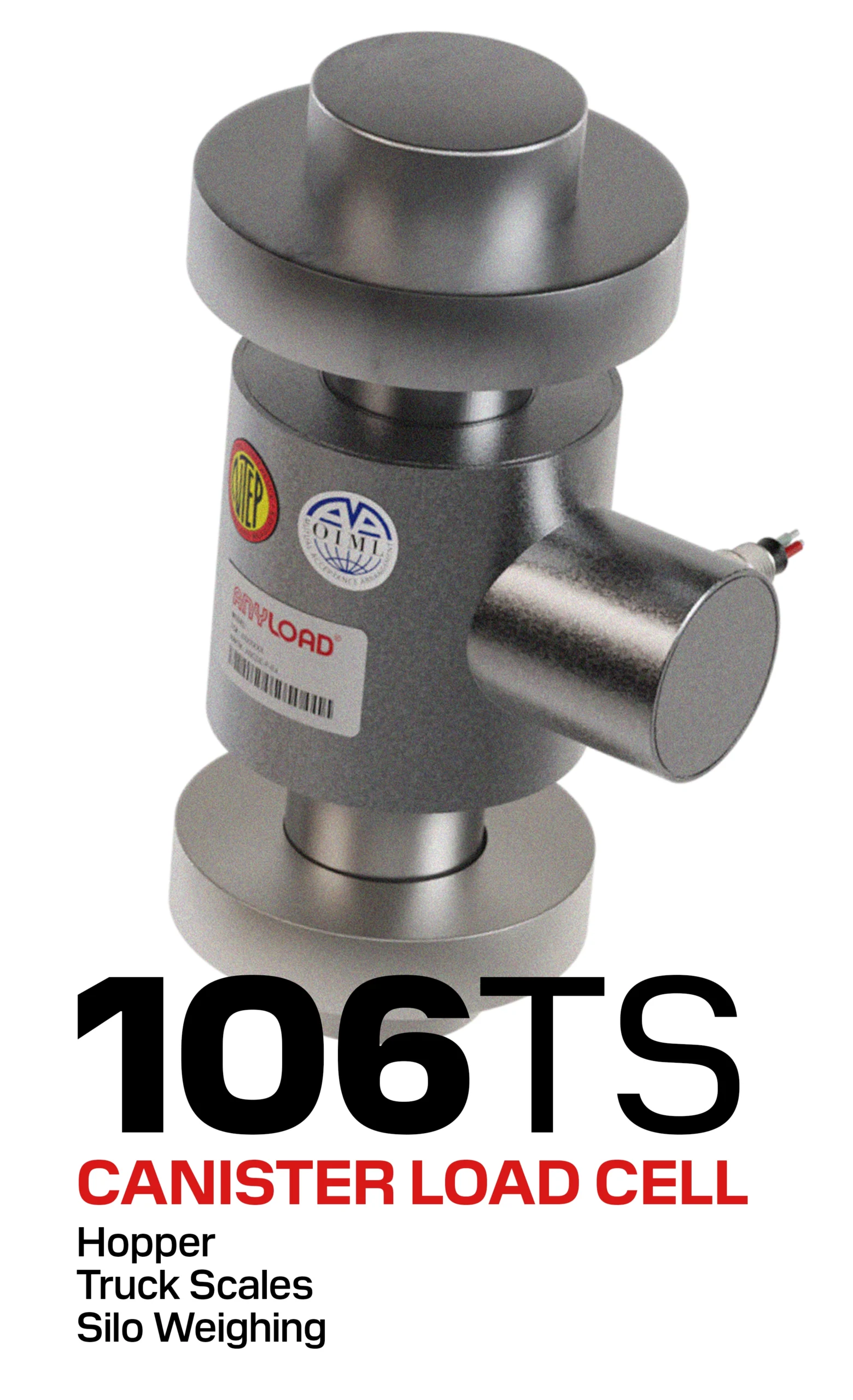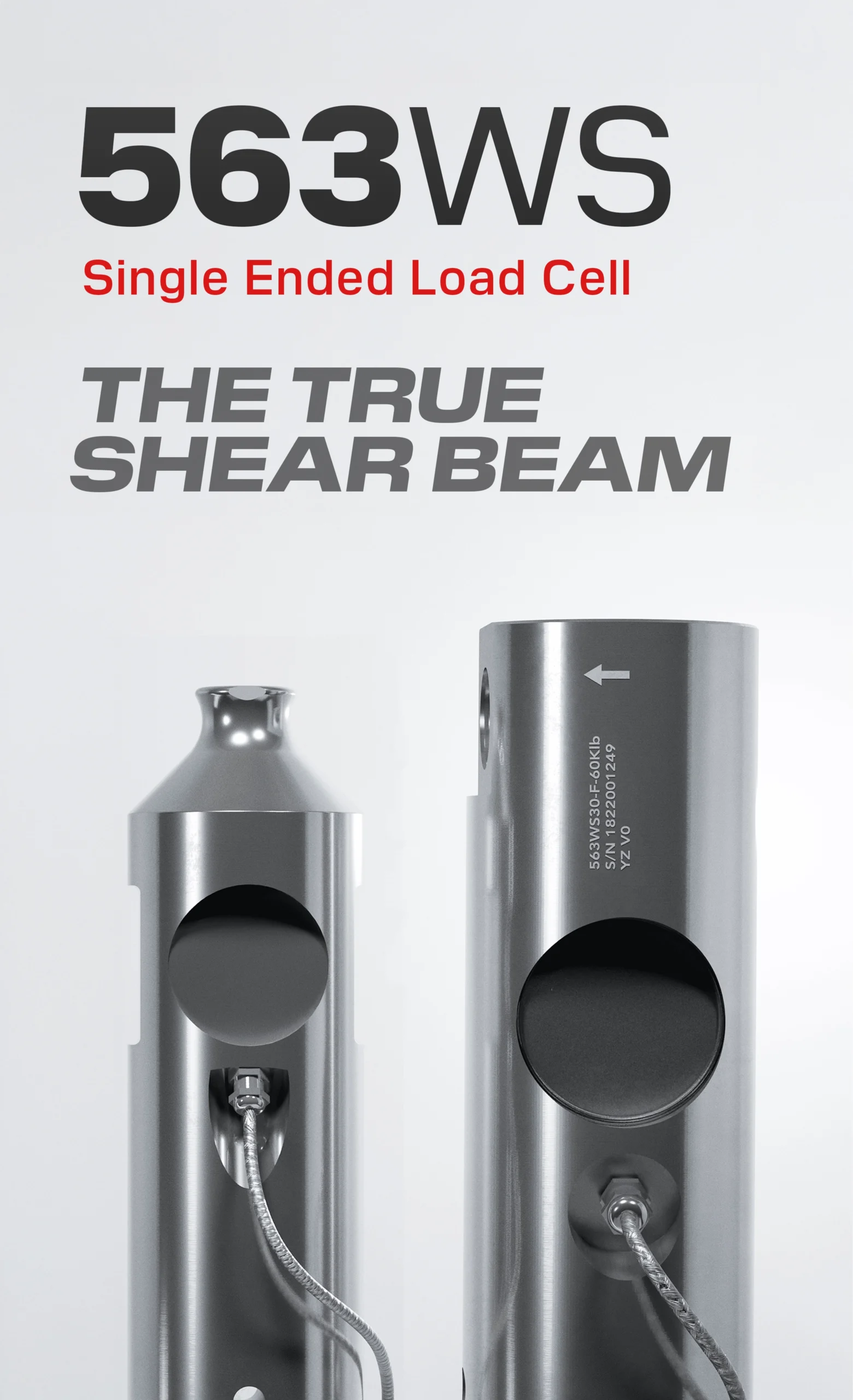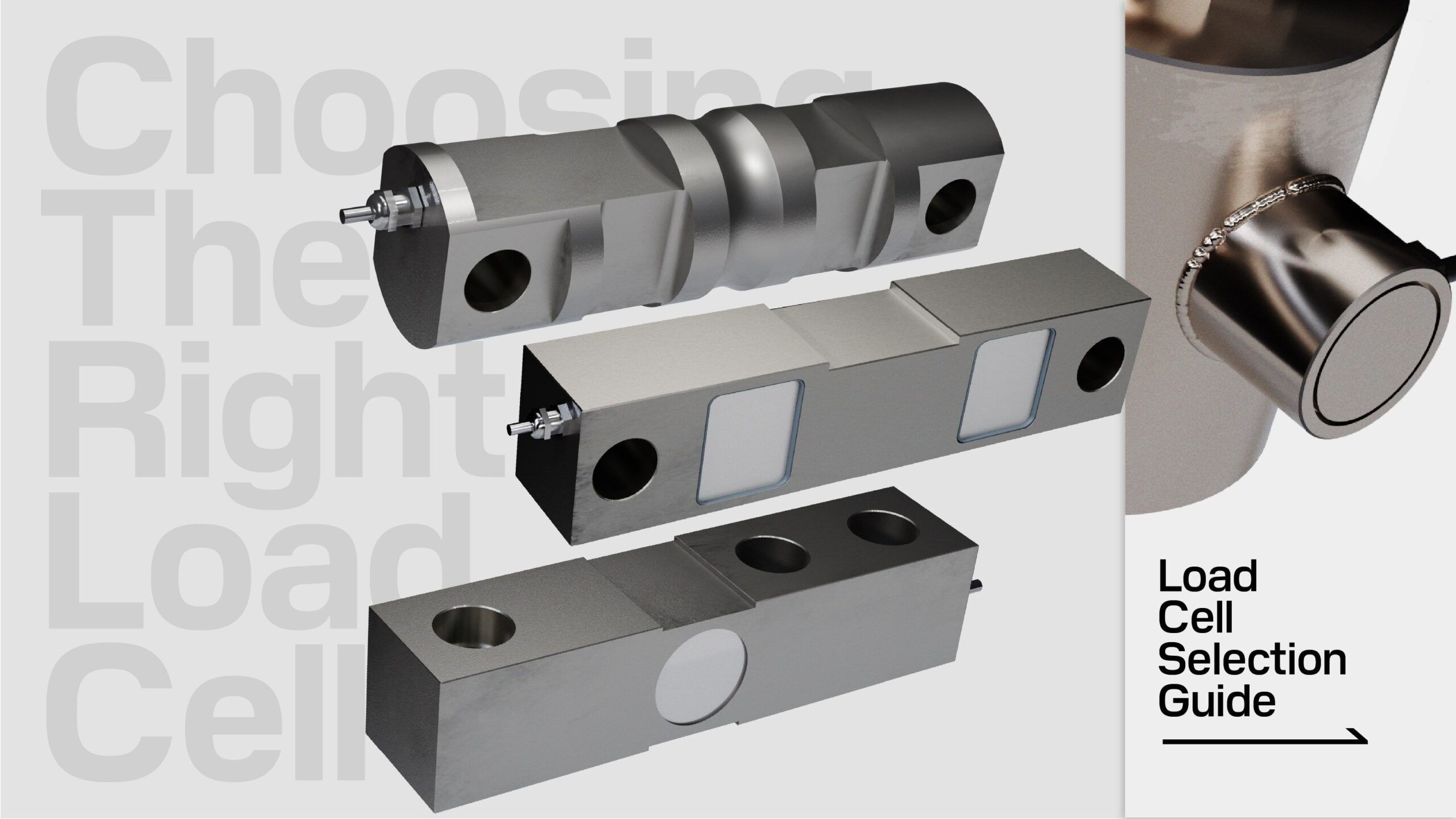Load Cell Specifications Guide
Last Updated On August 27 • 15 min read
When selecting a load cell for your application, understanding the various specifications is crucial for ensuring optimal performance, accuracy, and reliability. This comprehensive guide to load cell specifications covers everything you need to know about the terms and figures that regularly appear in technical drawings, datasheets, calibration certificates, and other documents.
By grasping these specifications, you can make informed decisions to select the best load cell for your needs. Whether you are dealing with industrial weighing, precision laboratory measurements, or dynamic applications, understanding these parameters will help you ensure accurate and reliable performance.
1. Rated Capacity (Emax)
DEFINITION: Rated Capacity, also sometimes referred to as full scale (FS) capacity, maximum capacity, or Emax, refers to the maximum load that a scale or load cell is designed to measure. This value is specified by the manufacturer and represents the upper limit of the weighing system’s operating range, ensuring reliable and accurate performance without causing accelerated fatiguing, damage, or significant error beyond standard tolerance.
EXPRESSION: Unit of weight (e.g., kilograms, pounds) or force (e.g., Newtons).
FURTHER INFORMATION: It is common for one model of a load cell to be available in multiple rated capacities. This flexibility allows the same basic design to be used across different applications, which may require different load ranges. The variations in rated capacities for a single load cell model can be achieved through primarily through:
- Mechanical Design: By varying the physical size and structure of the load cell, manufacturers can alter its rated capacity. Larger sizes can handle higher loads, while smaller sizes are suitable for lower capacities. As such, load cells can often have different dimensions at different capacity ranges.
- Strain Gauge Rating: The strain gauges used in load cells can be selected to handle different ranges of strain, which directly affects the load cell’s rated capacity. Higher-rated strain gauges can measure larger forces without becoming damaged or losing accuracy.
2. Full Scale Output
DEFINITION: Full Scale Output (FSO), also known as rated output, is the electrical signal output produced by a load cell when the maximum rated load (Emax) is applied.
EXPRESSION: Millivolts per volt (mV/V). This means that for every volt of excitation supplied to the load cell, the output signal will be a certain number of millivolts when the load cell is loaded to its rated capacity (Emax).
Example: A load cell with a rated capacity (Emax) of 10,000 kg and an FSO of 2 mV/V ± 0.25% means that when 10,000 kg is applied, the load cell will produce an output of ~2 mV (plus or minus 0.25%) for every volt of excitation. If the excitation voltage is 10V, the output signal at full capacity would be 20 mV with an error margin of ±0.05 mV. Thus, the output signal at full capacity could range between 19.95 mV and 20.05 mV.
FURTHER INFORMATION:
- Most standard load cells typically have a FSO of 2mV/V or 3 mV/V.
- The FSO indicates how much the output signal changes with a given load. Higher FSO values generally mean higher sensitivity, allowing for more precise measurements at lower loads, but are more susceptible to overload.
- However, rated output is the load cell’s electrical output when it is loaded to its rated capacity load, and full scale output is generally the range of output values (also called the span) throughout the measuring range of the load cell (that is its output at maximum load minus the output at minimum load).
3. Zero Balance
DEFINITION: Zero Balance, also known as zero offset, is the output signal of a load cell when no load is applied. Ideally, this output should be zero, but due to manufacturing tolerances and environmental factors, there is usually a small non-zero output.
EXPRESSION: Millivolts per volt (mV/V).
For example, a zero balance specification of ±0.02 mV/V indicates that the load cell output with no load can vary by up to 0.02 mV for every volt of excitation.
FURTHER INFORMATION:
- During initial calibration, the zero balance is measured and recorded. This value is then used to adjust the output signal to ensure accurate load measurements. Any significant deviation in zero balance after installation or during use can indicate potential issues with the load cell or its setup.
- How a load cell is installed can affect the zero balance. Factors such as mounting surface flatness, torque on mounting bolts, and alignment can introduce or correct zero balance deviations.
- Over time, the zero balance of a load cell may drift due to material relaxation or environmental exposure.
4. Non-Linearity
DEFINITION: Non-linearity in a load cell refers to the deviation of the load cell’s output from a straight line that represents the ideal response across the entire range of the load cell. It is a measure of how much the actual output curve deviates from the ideal linear curve.
EXPRESSION: Percentage of the full scale output (FSO).
For example, a non-linearity specification of < ±0.017% FSO indicates that the maximum deviation from the ideal linear output is less than ±0.017% of the FSO.
FURTHER INFORMATION:
- The ideal load cell response is a straight line where the output is directly proportional to the applied load. Non-linearity measures how much the actual output deviates from this ideal line.
- Non-linearity contributes to the overall error in load cell measurements. Even small deviations can affect accuracy, particularly in applications requiring high precision.
- Modern load cells are often designed with built-in compensation to correct for non-linearity. Calibrated instrumentation can also help minimize the effects of non-linearity on measurement accuracy.
5. Repeatability
DEFINITION: Repeatability in a load cell refers to the ability of the load cell to produce consistent output readings when the same load is applied multiple times under the same conditions. It is a measure of the variability in the output signal for repeated applications of the same load.
EXPRESSION: Percentage of the full scale output (FSO).
For example, a repeatability specification of ±0.01% FSO indicates that the output variation for repeated applications of the same load is within ±0.01% of the FSO.
FURTHER INFORMATION:
- High repeatability indicates that the load cell can consistently produce the same output for the same applied load, which is essential for accurate and reliable measurements.
- During the calibration process, repeatability is tested by applying the same load multiple times and recording the output. The variation in these outputs is used to determine the repeatability specification.
6. Hysteresis
DEFINITION: Hysteresis in a load cell refers to the difference in the output signal when the same load is applied, depending on whether the load is approached from an increasing or decreasing direction. It measures the lag in the load cell’s response to changes in load, which can cause inaccuracies in the output signal.
EXPRESSION: Percentage of the full scale output (FSO).
For example, a hysteresis error specification of ±0.02% FSO indicates that the difference in output due to hysteresis is within ±0.02% of the FSO.
FURTHER INFORMATION:
- Hysteresis error occurs because the load cell’s output can vary depending on the path taken to reach a specific load. This means the output when loading up to a certain weight might differ from the output when unloading from a higher weight to the same value.
- Hysteresis is influenced by the mechanical properties of the materials used in the load cell, including the strain gauges and the load cell structure. Materials that do not return perfectly to their original shape after being loaded can contribute to hysteresis error.
Application: Hysteresis error is particularly critical in dynamic applications where loads are continuously cycled, such as in industrial weighing systems, testing machines, and automation equipment.
7. Creep
DEFINITION: Creep in a load cell refers to the change in the output signal when a constant load is applied over a specific period, typically measured in 30 minutes. It is a measure of the load cell’s stability and ability to maintain a constant output under a sustained load.
EXPRESSION: Percentage of the full scale output (FSO) over a specified time period, usually 30 minutes.
For example, a creep specification of ±0.03% FSO in 30 minutes indicates that the change in output under a constant load will not exceed ±0.03% of the FSO over a 30-minute period.
FURTHER INFORMATION:
- Creep measures the ability of a load cell to maintain a stable output under a constant load. A load cell with low creep will exhibit minimal change in output over time, ensuring reliable measurements.
- Creep is influenced by the viscoelastic properties of the materials used in the load cell, including the strain gauges and the load cell body. Materials that exhibit minimal deformation under sustained load contribute to lower creep.
Application: Creep is particularly critical in applications such as material testing, industrial weighing, and structural monitoring, where loads are applied for extended periods.
8. Input Resistance
DEFINITION: Input resistance in a load cell refers to the electrical resistance measured across the input terminals of the load cell, specifically between the positive excitation (+EXC) and negative excitation (-EXC) leads. This parameter is critical for the proper functioning and compatibility of the load cell with the excitation voltage provided by the signal conditioning electronics.
EXPRESSION: Ohms (Ω).
For example, an input resistance specification of 400Ω ±25Ω indicates that the resistance between the excitation terminals can range from 375Ω to 425Ω. The specified tolerance (e.g., ±25Ω) accounts for variations in the manufacturing process.
FURTHER INFORMATION:
- The input resistance must match the requirements of the excitation voltage supply used in the weighing system. This ensures efficient power delivery to the load cell and accurate signal measurement.
- Measuring input resistance can be part of diagnostics to verify the functionality of the load cell. Significant deviations from the specified input resistance can indicate issues such as internal damage or wiring problems.
9. Output Resistance
DEFINITION: Output resistance in a load cell refers to the electrical resistance measured across the output terminals of the load cell, specifically between the positive signal (+SIG) and negative signal (-SIG) leads.
EXPRESSION: Ohms (Ω).
FURTHER INFORMATION:
- The specified tolerance (e.g., ±3Ω) accounts for variations in the manufacturing process.
- The output resistance must match the requirements of the measurement and signal conditioning equipment.
- High-quality load cells are designed to maintain stable output resistance across a range of operating temperatures.
10. Recommended Excitation
DEFINITION: Recommended excitation, also referred to as the “rated excitation,” refers to the optimal voltage range that should be applied to the load cell for accurate and reliable operation. This voltage powers the load cell’s internal circuitry, particularly the strain gauges, to produce a measurable output signal in response to applied loads.
EXPRESSION: Volts (V), along with a maximum allowable voltage.
For example, a load cell might specify a recommended excitation of 10V with a maximum of 15V, indicating that while 10V is ideal for optimal performance, the load cell can safely operate up to 15V.
FURTHER INFORMATION:
- The load cell can typically function over a range of excitation voltages, but using the recommended voltage helps achieve the best performance and accuracy.
- The maximum allowable voltage, such as 15V, provides a safety margin to prevent damage to the load cell. Exceeding this maximum voltage can cause excessive heat, potential failure, or permanent damage to the strain gauges and other internal components.
- The power supply providing the excitation voltage should be stable and free of electrical noise to avoid introducing errors into the load cell output signal.
11. Insulation Resistance
DEFINITION: Insulation resistance in a load cell refers to the electrical resistance between the load cell’s electrical circuit and its metal body or shield. It is a measure of how well the load cell’s electrical components are isolated from the load cell body, preventing unwanted current leakage and ensuring accurate measurements.
EXPRESSION: Giga-ohms (GΩ), with a specified test voltage.
For example, an insulation resistance specification of >2 GΩ (50V DC) indicates that the resistance is greater than 2 giga-ohms when tested with a 50-volt direct current (DC) supply.
FURTHER INFORMATION:
- High insulation resistance prevents leakage currents between the electrical components and the load cell body, which can cause measurement errors and noise in the output signal.
- High insulation resistance contributes to the long-term stability of the load cell by protecting it against moisture ingress, contamination, and electrical degradation.
12. Compensated Temperature Range
DEFINITION: The compensated temperature range of a load cell refers to the range of temperatures over which the load cell is designed to maintain its specified performance, accuracy, and stability. Within this range, the load cell’s internal temperature compensation mechanisms work to minimize errors caused by temperature variations.
EXPRESSION: Degrees Celsius (°C) and or Fahrenheit (°F).
FURTHER INFORMATION:
- Load cells are equipped with internal compensation mechanisms that adjust the output signal to counteract the effects of temperature changes.
- Manufacturers test load cells across the compensated temperature range to ensure that they meet performance specifications under varying temperature conditions.
- In industrial environments where temperatures can vary significantly, load cells with a wide compensated temperature range ensure reliable performance and accuracy.
13. Temperature Effect (on Zero Balance & Sensitivity)
DEFINITION: This specification refers to the change in the load cell’s zero output signal (zero balance) or sensitivity due to changes in ambient temperature. It indicates how much the zero balance or sensitivity drifts per degree of temperature change.
EXPRESSION: Percentage of the full scale output (Cn) per degree Celsius (or Kelvin).
For example, a specification of < ±0.0040% of Cn/°C indicates that the zero balance or sensitivity will change by less than ±0.0040% of the full scale output for each degree Celsius of temperature variation.
FURTHER INFORMATION:
- Monitoring ambient temperature and using load cells within their compensated temperature range helps minimize the impact of temperature variations. Implementing environmental controls, such as temperature-stabilized enclosures, can further reduce temperature effects on load cell performance.
- In environments with significant temperature fluctuations, such as outdoor or industrial settings, load cells with low temperature effects on zero balance and sensitivity provide more reliable and accurate measurements.
14. Safe Overload
DEFINITION: The safe overload capacity of a load cell refers to the maximum load that can be applied without causing permanent damage or significant degradation of performance. It is typically expressed as a percentage of the full scale capacity.
EXPRESSION: Percentages of the full scale (FS) capacity.
For example, safe overload might be 150% of FS, meaning that the load cell can safely handle loads up to 150% of its rated capacity without damage.
FURTHER INFORMATION:
- Load cells often experience varying loads, including accidental overloads. Understanding the safe overload capacity helps in designing systems that can tolerate these variations without compromising safety or performance.
- ANYLOAD load cells are subjected to rigorous testing to verify their safe overload capacities. Every single load cell is tested to its safe overload capacity to provide an added degree of reliability.
15. Breaking Overload
DEFINITION: The breaking overload capacity is the maximum load that a load cell can withstand before experiencing catastrophic failure. This threshold is also expressed as a percentage of the full scale capacity.
EXPRESSION: Percentages of the full scale (FS) capacity.
For example, breaking overload might be 300% of FS. This means that the load cell can withstand loads up to 300% of its rated capacity before breaking.
FURTHER INFORMATION:
- Applications involving dynamic or impact loads benefit from knowing the breaking overload capacity. This ensures that the load cell can withstand sudden force spikes without catastrophic failure.
- In systems where overloads are likely, implementing measures such as load limiters or shock absorbers can help protect the load cell from excessive loads.
16. Seal Type & IP Rating
DEFINITION:
- Seal Type: The seal type of a load cell refers to the method used to protect its internal components from environmental factors such as moisture, dust, and contaminants. Load cells are generally environmentally sealed (using epoxy and steel caps) or welded sealed.
- IP Rating: The IP (Ingress Protection) rating is a standardized measure of the degree of protection provided by the load cell’s enclosure against the ingress of solid particles and liquids.
EXPRESSION: Seal types are described by their specific method of sealing (environmental or welded), while IP ratings are expressed as IPXX, where XX are numerical digits.
For example, IP67 indicates a high level of protection against dust and temporary immersion in water.
FURTHER INFORMATION:
- The choice of seal type and corresponding IP rating ensures that the load cell can withstand specific environmental conditions, such as exposure to dust, water, and corrosive substances.
- Higher IP ratings indicate greater protection and suitability for harsher conditions.
17. Cable Color Code
DEFINITION: The cable color code of a load cell refers to the standardized color scheme used for the wiring of the load cell’s electrical connections. This color coding helps identify the function of each wire, ensuring correct installation and connectivity.
EXPRESSION: Each wire color alongside its corresponding function.
For example:
- Exc+ (Excitation Positive): Red
- Exc- (Excitation Negative): Black
- Sig+ (Signal Positive): Green
- Sig- (Signal Negative): White
- Shield: Bare
FURTHER INFORMATION:
- Always refer to the load cell manufacturer’s manual for the specific color code and wiring instructions, as there may be variations between different models or manufacturers.
- Ensure all connections are secure and properly insulated to maintain signal quality and safety.
18. Combined Error
- Components of Combined Error:
- Non-Linearity: The deviation of the load cell’s output from a straight line over the measurement range.
- Hysteresis: The difference in the load cell’s output when the same load is approached from increasing versus decreasing directions.
- Root Sum Square (RSS) Method: Combined error is often calculated using the root sum square method to account for the combined effects of non-linearity, hysteresis, and repeatability.
- Combined Error = √((Non-Linearity)² + (Hysteresis)² + (Repeatability)²)
19. Deflection (at Emax)
DEFINITION: Deflection at Emax refers to the amount of vertical displacement or deformation that occurs in a load cell when it is subjected to its maximum rated load (Emax). This measurement indicates how much the load cell bends or deflects under full load conditions.
EXPRESSION: Millimetres (mm).
For example, a deflection range of 0.04 mm to 0.14 mm at Emax indicates that when the load cell is loaded to its full rated capacity, it will deform by an amount within this specified range.
FURTHER INFORMATION:
- Deflection represents the elastic deformation of the load cell material under load. It is a temporary change in shape that disappears when the load is removed, assuming the load cell is not overloaded beyond its elastic limit.
- Excessive deflection can affect the accuracy of load measurements, especially in applications requiring high precision. Load cells with controlled deflection provide more reliable data.
- In applications where space and movement constraints are critical, understanding the deflection range helps in selecting a load cell that fits the mechanical design requirements without interfering with other components.
20. Estimated Weight
DEFINITION: The estimated weight of a load cell, excluding any additional accessories, mounting hardware, or packaging. This weight is a physical property that can impact the installation and application of the load cell, and also helps to inform product fulfilment logistics.
EXPRESSION: Kilograms (kg) or pounds (lb).
FURTHER INFORMATION:
- Knowing the weight of the load cell helps in planning for its installation, particularly in situations where manual handling is required. Lighter load cells are often easier to handle and install.
- In applications such as portable weighing systems or mobile equipment, the weight of the load cell can impact the overall system weight and mobility.
- The material used in constructing the load cell, such as alloy steel, stainless steel, or aluminum, directly impacts its weight. Load cells made from aluminum are typically lighter than those made from steel.
21. Minimum Dead Load (emin)
DEFINITION: Minimum Dead Load, or Load Cell Minimum Capacity (emin) refers to the manufacturer’s rating for the smallest load that can be accurately measured by the load cell without exceeding the maximum permissible error as defined by its certified accuracy class (OIML, NTEP, other). It represents the lower limit of the load cell’s effective measurement range.
EXPRESSION:emin is typically expressed in the same units as the load cell’s maximum capacity (emax), such as kilograms (kg), pounds (lb), or Newtons (N).
FURTHER INFORMATION:
- emin indicates the threshold below which the load cell’s measurements may not meet the specified accuracy.
- In some load cells, the emin value may be equal to zero (0). This indicates that the load cell can accurately measure loads starting from zero, making it suitable for applications requiring measurements from a no-load condition.
22. Minimum Verification Interval (Vmin)
DEFINITION: The Minimum Verification Interval (Vmin) is the smallest increment of load that can be accurately measured and verified by a load cell or scale. It represents the minimum weight change that can be reliably detected and is used to determine the load cell’s resolution and precision during calibration and verification processes.
EXPRESSION: Units of weight, such as kilograms (kg), pounds (lb), or grams (g).
FURTHER INFORMATION:
- Vmin indicates the load cell’s capability to detect and measure small weight changes. A lower Vmin value means the load cell can detect finer increments, which is essential for applications requiring high precision.
- For NTEP: In scales using more than one load cell, vmin must be less than or equal to the scale division divided by the square root of the number of load cells. In single load cell scales, vmin must be less than or equal to the scale division figure.
23. Y-Value (Relative Vmin)
DEFINITION: Y-Value is a calculated value also known as Relative Vmin. Y-value is the ratio of the Maximum Cell Capacity (Emax) to the Minimum Load Cell Verification Interval (Vmin). This ratio describes the resolution of the load cell independent from the load cell capacity.
EXPRESSION: Y-value is expressed as a ratio
It is calculated by dividing the load cell’s maximum capacity (Emax) by its minimum load cell verification interval (Vmin). For example, a load cell with an Emax of 10,000 kg and a Vmin of 1 kg would have a Y-Value of 10,000.
FURTHER INFORMATION:
- The Y-Value reflects the load cell’s resolution relative to its capacity. A higher Y-Value indicates that the load cell can measure smaller increments relative to its maximum capacity, providing better resolution and accuracy.
- Adhering to Y-Value specifications is important for compliance with regulatory standards such as OIML, NTEP, and other industry-specific guidelines.
24. Apportionment Factor (PLC)
DEFINITION: The apportionment factor (PLC) is a value used in the context of load cell calibration and verification to distribute the maximum permissible error (MPE) among multiple load cells in a weighing system. It reflects the proportion of the total allowable error that can be attributed to an individual load cell within the system.
EXPRESSION: PLC is typically expressed as a decimal or percentage.
For example, a PLC of 0.7 indicates that 70% of the total allowable error is assigned to a load cell (assuming it is a single cell system).
FURTHER INFORMATION:
- The apportionment factor of a weighing system is determined and changes based on its design and configuration. It takes into account factors such as the number of load cells and their individual roles in the system.
- When calibrating or verifying the system, PLC is applied to the MPE to calculate the allowable error for each load cell.
25. Maximum Number of Verification Intervals (nmax or nLC)
DEFINITION: The Maximum Number of Verification Intervals (nmax) refers to the highest number of discrete intervals into which the load cell’s measurement range can be divided while still maintaining the specified accuracy. It is an indicator of the load cell’s resolution and precision.
EXPRESSION: nmax is typically expressed as an integer value.
For example, an nmax of 3000 indicates that the load cell’s measurement range can be divided into 3000 equal intervals, each representing a verification point.
FURTHER INFORMATION:
- nmax represents the granularity of the load cell’s measurement capability. A higher nmax value indicates a finer resolution, allowing the load cell to detect smaller changes in load with higher precision.
- Each verification interval represents a small, equal segment of the load cell’s total measurement range. The total number of these intervals (nmax) determines how detailed and precise the measurements can be.
Conclusion
Different manufacturers and resellers have varied methodologies for providing load cell specifications. As such, there can be significant differences in how the data should be interpreted. Some may rely on theoretical calculations or industry-standard benchmarks, while others might derive information from more rigorous live testing.
At ANYLOAD, we distinguish ourselves by only providing data that we have proven through extensive live testing using our comprehensive array of equipment. This approach ensures that our specifications are accurate and reliable, reflecting more accurately real-world performance rather than theoretical assumptions.
Additionally, in scenarios where there is uncertainty or a high risk of error, we may understate our figures. This conservative approach provides our customers with an added layer of security, ensuring that our load cells perform reliably even in the most demanding conditions. By prioritizing accuracy and reliability, we help our customers achieve precise and dependable measurements in their applications.
CONTACT US for more information or if you have any technical questions.









